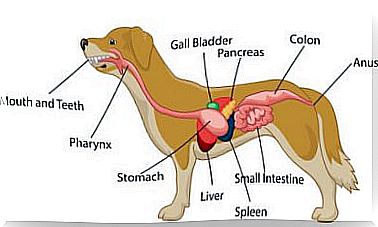Fever In Dogs, What Does It Mean In Each Case?

Like humans, dogs can get diseases and infections. An immune response to these infections is fever. However, there are several causes that can cause fever in dogs and it is necessary to look at the other symptoms before determining the disease that afflicts the dog.
What is fever?
Fever is defined as elevated body temperature caused by an immune response to inflammation or infection . The normal body temperature for dogs is about 39.5ºC, so the animal will only have a fever if its temperature exceeds 39.5ºC, but if it reaches 41ºC, complications and even death could occur.
How can I tell if my dog has a fever?

To know if your dog has a fever, his rectal temperature should be measured. To do this, use a thermometer specially designed for use in dogs, do not use a human thermometer and do not use the thermometer that you normally use for yourself.
To put the thermometer on your dog, lubricate it with petroleum jelly or baby oil and then gently insert the thermometer a couple of centimeters into your dog’s anus. You may need the help of another person to hold the dog while you do this, especially if the dog is very large. Wait for the results.
In addition to the thermometer, other symptoms that a dog with a fever may present are: tremors, a depressed mood with a tendency to lethargy, loss of appetite, vomiting, cough and runny nose.
What can cause fever in my dog?

The normal causes of fever in dogs are bacterial, fungal, and viral infections. The infection can be anywhere in the body. Symptoms will depend on the site of infection and the underlying cause. In addition, vaccines can also produce temporary fever, 24 to 48 hours after vaccination, while the dog’s body adjusts to the vaccine.
Consuming substances poisonous to dogs, such as macadamia nuts and some human antidepressants, can also cause fever. And of course, more serious illnesses like immune system disorders, bone marrow problems, undiagnosed infections, and cancer also cause fevers in dogs.
One of the viral causes of fever is the flu. If in addition to fever the dog has a cough, lethargy, loss of appetite, runny nose and seems to have a respiratory infection (if it has mucus or green phlegm), then it may have the flu. If these symptoms last for more than two days in a dog, a veterinarian should be consulted.
Like human flu, canine flu is treated with antibiotics to help protect against secondary infections, and if the flu occurs severely, the flu can turn into pneumonia. To prevent canine flu, it is best to keep your dog away from infected dogs.
If dogs are in frequent contact with other dogs, it is advisable to vaccinate them against canine flu, although the owner must assess the risks before deciding on vaccination. In either case, the flu virus is generally mild and if treated properly, infected dogs should be able to make a full recovery.
What do I do if my dog has a fever?
If your dog has a fever, especially if the fever is very high, it is best to take him to the vet. However, there are some home remedies that can be done temporarily to lower the animal’s fever, such as bathing it with cold water for 10 minutes, covering it with a damp towel, hydrating it with plenty of cold water, laying it down in the shade in a place cool and calm, place an ice pack on the legs, abdomen or head or give Echinacea or some medication prescribed by the veterinarian.









